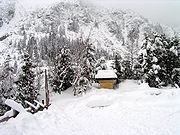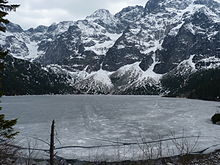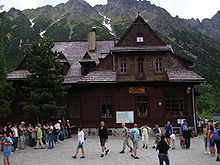- Morskie Oko
-
Morskie Oko 
Coordinates 49°11′50″N 20°4′15″E / 49.19722°N 20.07083°ECoordinates: 49°11′50″N 20°4′15″E / 49.19722°N 20.07083°E Lake type Moraine-dammed Primary outflows Rybi Potok Basin countries Poland Max. length 0.862 km Max. width 0.566 km Surface area 0.3493 km² Max. depth 50.8 m Surface elevation 1,395 m Morskie Oko (Slovak Morské oko; Hungarian Halastó literally "Marine Eye") is the largest and fourth deepest lake in the Tatra Mountains. It is located deep within the Tatra National Park, Poland, in the Rybi Potok Valley, at the base of the Mięguszowiecki Summits, in a region situated within the Lesser Poland Voivodeship.
Contents
Lake description
The peaks that surround the lake rise about 1,000 meters above its surface; one of them is Rysy (2,499 meters), the highest peak in the Polish Tatras. Beside Mięguszowiecki Summits (including Mięguszowiecki Szczyt Wielki, 2,438 meters), farther away and slightly to the left, is the distinctive, slender Mnich (“Monk,” 2,068 meters). Many Swiss Pines also grow around the lake.
In the past, Morskie Oko was called "Rybie Jezioro" ("Fish Lake") due to its natural stock of fish, which are uncommon in Tatra lakes and ponds. In the clear depths of the water, one can easily notice trout - so called "famine" trout - that live in the lake. The name "Morskie Oko" translates to "Eye of the Sea"; this is derived from an old legend, according to which the lake was connected to the sea via an underground passage.[1]
The hut of the Polish Tourist Country-Lovers' Society (PTTK) stands on the moraine that closes the lake from the north. The hut is situated 1,405 meters above sea level and belongs to the oldest Tatra chalets. The hut is named after Stanisław Staszic, who explored the lake in 1805. It is a point of departure for hikes to Rysy and Szpiglasowa Przełęcz. Nearby is the Stare Schronisko ("Old Shelter"), originally a coachhouse. Both buildings have been granted historical status.
Morskie Oko is one of the most popular destinations in the Tatras, often receiving over 50,000 visitors during the vacation season. It is reached by foot in about two hours from the nearest road that allows motorized access. Many other tourists opt to take the journey by horse-drawn cart, a large number of which are operated by the local Górale inhabitants. In winter, a short section of the journey is in an avalanche danger zone, and the area can remain cold and rainy even in summer. In the advent of its popularity, visitors have been forbidden from swimming in the lake or feeding the trout.
History
The earliest documents in which Morskie Oko is mentioned date back to 1575. In 1637, the Polish king Władysław IV granted Wladyslaw Nowobilski the right to use the pastures adjoining the area.
In 1824, during Partitions of Poland, Morskie Oko became private property for the time being, when Zakopane estate, including Dolina Rybiego Potoku, were purchased from the Austrian authorities by Emanuel Homolacs. At the end of the nineteenth century, a boundary dispute arose between Galicia and Hungary over property rights to the lake and adjoining area (the so-called "Morskie Oko dispute"). The Court of Conciliation in Graz ruled in favor of the Polish side. The decision is credited to Oswald Balzer, who represented the Galicia government.
Morskie Oko was "rediscovered" for tourism by Dr. Tytus Chałubiński in the mid nineteenth century; the first shelter was built there in 1836 but burned down in 1865. A second shelter, built in 1874, burned down in 1898. In 1902, a road from Zakopane was completed and named the Oswald Balzer Road. Since 1933 following the return of sovereignty, the lake has been owned by the Polish state.
The charm of Morskie Oko has provided inspiration to many artists, including painters (Walery Eljasz-Radzikowski, Leon Wyczółkowski, Stanisław Gałek), poets (Wincenty Pol, Adam Asnyk, Kazimierz Przerwa-Tetmajer, Franciszek Nowicki, Jan Kasprowicz), and composers (Zygmunt Noskowski).
References
- This article incorporates information from the equivalent article on the Polish Wikipedia.
External links
 Media related to Morskie Oko at Wikimedia CommonsCategories:
Media related to Morskie Oko at Wikimedia CommonsCategories:- Lakes of Poland
- Visitor attractions in Poland
- Lesser Poland Voivodeship
- Mountain lakes
Wikimedia Foundation. 2010.





